Jan-15-11
 | | GrahamClayton: Here is a Burns game that is not in the database:
[Event "Consultation game"]
[Site "Melbourne, Australia"]
[Date "1875.10.??"]
[Round "?"]
[White "Burns, Andrew + Phillips, L"]
[Black "Goldsmith, Louis + Sedgefield, S"]
[Result "1-0"]
1. e4 e5 2. f4 Bc5 3. Nf3 d6 4. Bc4 Nf6 5. Nc3 O-O 6. Qe2 Bg4 7. Na4 Nc6 8. c3 exf4 9. d4 Re8 10. O-O Rxe4 11. Qc2 Bb6 12. Nxb6 axb6 13. Ng5 Re7 14. Bxf4 Bh5 15. Bxd6 Qxd6 16. Rxf6 Bg6 17. Rxf7 Rxf7 18. Bxf7+ Bxf7 19. Qxh7+
Kf8 20. Rf1 Nd8 21. Nxf7 Nxf7 22. Qh8+ Ke7 23. Qxa8 Qe6 24. Qxb7 Kd7 25. Qf3 1-0 Source: Anthony Wright, “Australian Chess to 1914”, Melbourne, 1995 |
|
Feb-20-11
 | | GrahamClayton: Burns was a veteran of 15 telegraph matches (+12, -2, =1)between Victoria and the other Australian colonies, and was a founder and early president of the Melbourne Chess Club. He won its first annual handicap tourney in 1867 as the only competitor playing from scratch, and there was no acceptor when, 2 years later, he offered pawn and move to any player in the colony of Victoria. Burns was the chess columnist for the "Leader" newspaper from 1869 until 1901. |
|
| Aug-11-15 | | optimal play: Obituary from “The Leader” (Melbourne, Vic.) issue Saturday 22 June 1901 page 43 THE LATE MR. ANDREW BURNS.
The doyen of Australian chess is dead.
We deeply regret to have to record the death of Mr. Andrew Burns, who from June, 1869, to the end of July, 1900, continuously occupied the position of chess editor of this journal. Mr. Burns's death occurred at his residence, 35 Elgin-street, Hawthorn, on Thursday, 13th inst., in the 71st year of his age. The illness which proved his last overtook him at the end of August, 1899, and our chess column of 2nd September in that year is the last one to which he was able to give any personal supervision. The beginning of the illness was an attack of influenza, and a chill supervening brought on liver contraction and jaundice. From the effects of this illness he never rallied to anything like his ordinary mental and physical vigor; and a return of the graver symptoms of his malady, with other complications, during the last month or two, when his recuperative powers had given out, left no hope of recovery. Mr. Burns was a Scotsman, having been born at Glasgow on 14th February, 1831. He received his education at the High School and the University of that city. He emigrated to Australia in 1853, and arrived in Melbourne in May of that year. He had made some slight acquaintance with chess in his native land, but practically the growth of his chess play was entirely Australian. It was about the year 1857 that he commenced to play at a coffee-house in Bourke-street, called the City Buffet, a chess resort which witnessed the youthful rivalries of many Victorian players who are now referred to among us as units of the "Old Brigade." Here, L. Goldsmith, the late L. S. Phillips, P. D. Phillips, L. Ellis, the late W. Tullidge and others, had their first meetings. In the year 1866 a tournament was held with about 20 competitors. In this contest Mr. Burns was handicapped with 7 others in the 1st class. He won the 1st prize, losing one game only, that with Ellis. In a handicap tourney held the following year, with 23 entrants, he was handicapped in the 1st division of class 1. In the 2nd division were, among others, Candler, Goldsmith, Sedgefield and Tullidge. He tied with Tullidge, with a score of 19 wins and three losses. In the play-off he won with a clean score of three games, giving the move in each game. The next tournament he entered was one in 1869, which attracted 25 competitors. He was handicapped alone in class 1., giving class 2 pawn and move. He again succeeded in winning the first prize, making a score of 20 games won, 2 lost, and 1 drawn. Subsequently he played various private matches, giving odds in each case, nearly all of which he won. Among those duelli were one with Sedgefield at pawn and move, Burns winning by 6 to 2, and another with Connell at same odds, won by Burns by 5 to 1. He was, however, defeated by Goldsmith and Sedgefield in short matches, at pawn and move odds in each case, by the odd game. At this period his play was the subject of much favourable comment in leading European chess organs. We cite instances of this. In the September, 1872, number of the "Westminster Papers" (a high class English exponent of the game) we find it expressed that "Mr. Burns, of Melbourne, would take high rank as a player in London or Berlin." In the "Glasgow Herald," of 9th October, 1880, it is affirmed that "he is looked upon by many as quite equal to any of our home experts." ...continued... |
|
| Aug-11-15 | | optimal play: ...continued...
After the matches referred to, his practice was very little until 1879, when he entered the arena again in competition for a challenge cup, which was to be won twice by a competitor before being taken absolutely. He was again handicapped alone in class I., giving pawn and move to class II. He again asserted his quality by becoming the first winner of the cup. In 1880 the second competition for the challenge cup took place. An interesting feature in this contest is the advent of Mr. F. K. Esling in Victorian chess, he being one of the competitors. Burns was handicapped as before, but was defeated by Esling, to whom he gave pawn and move, by the odd game - the score being Esling 3, Burns 2, drawn 1. Just after the conclusion of this tourney, Esling drew a match on even terms with Mr. John Wisker, the ex-English champion, who had then lately become one of the Melbourne chess circle. In 1880. Burns also contested 7 games with Wisker, not in a set match, winning 3 and drawing 4. It must, however, be pointed out that it is not likely Wisker would play these casual games so thoroughly as those of a set match; and, in any case, the English player was not at all, after his years of isolation in Queensland from any opponents worthy of his powers, the practiced player who had in the early seventies won the British Chess Association Challenge Cup at two successive meetings against such players as Blackburne, Burn, De Vere, Owen, Macdonnell, and others. In 1882 Burns finally won the Challenge Cup in the tourney for that year. Esling did not compete in this tourney. For the next two years Burns was not in any match, but in 1884 he entered the tournament in that year for another Challenge Cup. He was handicapped in the 1st class with Messrs. Fisher and Gossip, both of whom he defeated, and won the cup for the first time. In the following year Fisher succeeded in winning this cup. From this time onward it may be said that Burns engaged in no further serious contests, partly on account of growing years, and partly on account of business calls. In the telegraphic matches which have taken place between this State and New South Wales, he holds a fine record. Of 14 games played by him he won 11, lost 1 (to W. Crane, Jun., in 1885) and drew 2 (with Messrs. Russell and Ryan). The last game played by him, outside casual play, was that won by him against Mr. S. Henderson, in the match against New South Wales in 1895. He was one of the principal founders of the Melbourne Chess Club, which commenced its career in 1866. He frequently held the office of president, and also acted as treasurer for a number of years. He was a member of committee throughout until last year. He edited the chess column of this journal from the time when the column started, 12th June, 1869. Throughout the long period of his editorship, over 31 years, he conducted the column in a most able manner, and maintained it on a level with the best chess journalism of the time, which was testified to by many encomiums he received from correspondents in the European, American and Australian chess centres. ...continued... |
|
| Aug-11-15 | | optimal play: ...continued...
The high quality of his play when at his best was undoubted. It was of an attacking and combinative but straightforward character, and although he was not unmindful of modern theories, they did not make any appreciable impression on his style. He was by no means a laborious student of the openings, and did not regard with great favour or attention the ultra refinements and hypotheses with which it has become the fashion to beset the later theories of the openings. This is observable in his annotations, which do not betray great interest in this matter. Indeed, he has often remarked that this elaboration was more a thing to be deprecated than admired or toiled after. Although he was, notwithstanding his style of play, not so brilliant an odds giver generally as the late C. M. Fisher, there was one branch in which he achieved a distinguished facility. This was in rendering the difficult odds of pawn and move and pawn and two moves. In his palmiest days he was in the habit of playing most successfully at these odds with powerful players. His games in this respect remind one of the patience, tenacity and quick perception and acquisition of positional advantages which illuminate the great series of games at these odds fought by England's whilom champion, Howard Staunton. Into the domain of problems he did not make much excursion, and in this department of the game did not show any power of composition or technically artistic view. His analytical powers, however, made him keen to detect second solutions and defects of construction not associated with style. It was as an analyst and an annotator that he shone; and, in this way, the masterly work he put into this column during his long connection with it greatly contributed to its prestige. It can be unhesitatingly said that his free and sound method of play impressed itself upon the Melbourne school of players who graduated under his influences, and has in no small degree helped to that position which Victoria has hitherto retained in Australian chess. ...continued... |
|
| Aug-11-15 | | optimal play: ...continued...
It is our province in this brief memoir to speak of Mr. Burns as chess player, but we feel, we could not lay down our pen without referring to him as a man — as to how he bore himself among his fellows in their drama of life. Doubtless, in matters pertaining to chess, he was apt at times to be dictatorial and exclusive, to hold strong opinions and express them strongly. It is asserted that to younger players he might have been more gracious and encouraging, both in his intercourse with them, and his criticism of their play. It may be so, but this did not arise from pride or ill-nature. He was not sociable in the ordinary acceptation of the term: he did not win regard as others with more superficial traits are apt to do: and if his criticism was at times not indulgent, it was, at any rate, not tainted with insincerity or unworthy motive. In the general walk of life it can be said of him, without fear of contradiction, that he was honourable, and tender-hearted. Reticent, like most of his race, he was, to those who knew him best, sympathetic and generous. To these are known many an instance of his kindnesses to chess players and non-chess players, in times of trouble and adversity; and many, doubtless, will be never known. He was not destined to go through life himself without tribulation. The loss of his only son, Islay in 1866, when a bright boy about 10 years of age, was a grief which through all the after years had some abiding place with him. It was this, more than anything, which impelled him to turn to chess, and in that absorption to find some solace. It is sad to think, too, that his closing years were clouded by mischance. The death of his wife in 1891 was soon afterwards followed by grave reverses to his fortune, consequent upon the financial troubles of that period. He also became involved in a prosecution levelled against the directors and auditors of the City of Melbourne Bank, of which he was an auditor. It was not thought for a moment that any moral blame attached to him or his co-auditor in this matter, and there was no hint of such in the prosecution, but it was in every way gratifying to his friends that even in a technical aspect the prosecution failed. These prolonged and severe anxieties told greatly upon his sensitive temperament, and with the growing weight of years made serious inroads upon his cheerfulness and health, and no doubt paved the way to his fatal illness. For all this, he made little outward complaint, and dismissing the expectation he had cherished for some leisure in his declining days, he kept unflinchingly at the work of auditor and accountant, in which for so many years he had toiled for a competence that now had slipped from him, but keeping the honour and integrity which through all vicissitude had not failed or dimmed. The deceased player had considerable taste in the direction of art, especially in painting, and the splendid collection of works, principally in water colour, he had formed was a great feature in his home. Among those, and much prized by him, was a fine water colour by S. S. Boden, the noted English chess master, who was also an artist of considerable ability in water colours. The funeral of Mr. Burns took place on Saturday last, 15th inst., when his remains were interred in the Melbourne General Cemetery. Besides relatives and other friends, a number of chess players attended to pay a last tribute. Among these wore Messrs. F. H. Wilson, Esling, Clezy, P. D. Phillips, H. E. Grant, Witton, Crewe, Miscamble, T. Taylor, Stabback, Bradshaw and Gurden. Mr. Burns was married a second time, and leaves a widow and one daughter by his first marriage, who is now the wife of Mr. Palmer of the Melbourne Stock Exchange. A portrait of the deceased, from a photograph taken in 1896, appears in another part of the present issue of the paper. The following is a good sample of the late Mr. Burns's play. It was played in the tournament in Melbourne in 1866 A Burns vs W Tullidge, 1866
Another fine example of the late Mr. Burns's skill is the game below, played in May, 1885, in the tournament for the challenge cup then pending at the Melbourne Chess Club A Burns vs Gossip, 1885
- Leader (Melbourne, Vic.) issue Saturday 22 June 1901 page 43 |
|
| Aug-25-15 | | optimal play: BLINDFOLD CHESS AT THE MELBOURNE CHESS CLUB.
We are not aware that any specimen of this description of play in Victoria has yet appeared. The following game, recently played at the Melbourne Chess Club, will therefore probably be examined with interest by our readers. It may be mentioned that Mr Burns has had very little practice in this description of play. Between Messrs Burns and Paton, the former playing blindfold, and giving the odds of his Queen's Knight. (Remove White's Q Kt.)
Black: Mr Paton

click for larger viewWhite: Mr Burns (blindfold)
King's Gambit.
1. P to K 4 ; P to K 4 ; 2. P to K B 4 ; P takes P ; 3. Kt to B 3 ; P to K Kt 4 ; 4. B to B 4 ; B to Kt 2 ; 5. P to Q 4 ; P to Q 3 ; 6. Castles ; P to K R 3 ; 7. P to K Kt 3 ; P to Kt 5 ; 8. Kt to R 4 ; P to B 6 ; 9. B to B 4 ; Q Kt to B 3 ; 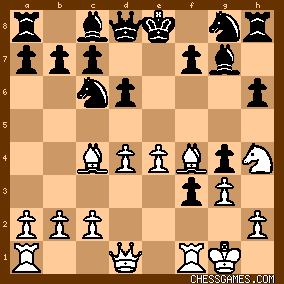
click for larger viewUp to this point black's moves are as good as can be made. 10. P to B 3 ; P to K R 4 ; 11. Q to Kt 3 ; Q to K 2 ; 12. Q R to K sq ; To enable him to play Kt to B 5
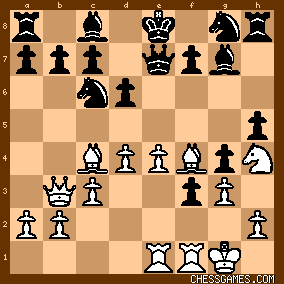
click for larger viewWhite has now a finely developed game.
12... Kt to R 4 ; 13. Q to R 4 (ch) ; Kt to B 3 ; 14. Kt to B 5 ; Q to B 3 ; 15. P to Q 5 ; B to Q 2 ; 16. P takes Kt ; B takes P ; 17. B to Q Kt 5 ; K to Q 2 ; 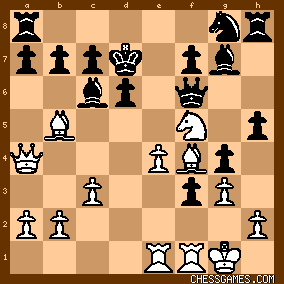
click for larger viewKt to K 2 is perhaps better, but white would still have got a fine attack by taking off the Kt, and then pushing his K P. 18. Kt to Q 4 ;
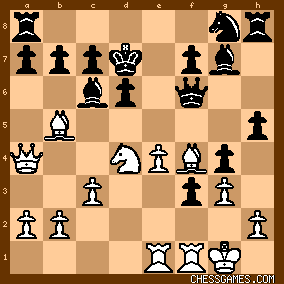
click for larger viewThe combination, of which this is the initial move, and which results in the winning of a piece by white, is worthy of attention, considering that the player had not the board before him. 18... Kt to K 2 ; 19. P to K 5 ; P takes P ; 20. B takes P ; Q to Kt 3 ;
21. B takes B ; Q takes B ; 22. R takes Kt (ch) ; K to B sq ; He evidently cannot take the rook without losing his queen. 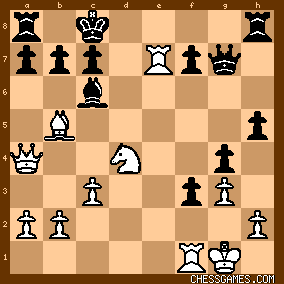
click for larger view23. B takes B ; P takes B ;

click for larger viewAnd white mates in two moves.
- Leader (Melbourne, Vic.) issue Saturday 23 October 1869 page 10 1.e4 e5 2.f4 exf4 3.Nf3 g5 4.Bc4 Bg7 5.d4 d6 6.O-O h6 7.g3 g4 8.Nh4 f3 9.Bf4 Nc6 10.c3 h5 11.Qb3 Qe7 12.Rae1 Na5 13.Qa4+ Nc6 14.Nf5 Qf6 15.d5 Bd7 16.dxc6 Bxc6 17.Bb5 Kd7 18.Nd4 Ne7 19.e5 dxe5 20.Bxe5 Qg6 21.Bxg7 Qxg7 22.Rxe7+ Kc8 23.Bxc6 bxc6 24.Qa6+ 1-0 |
|
|
|
|






